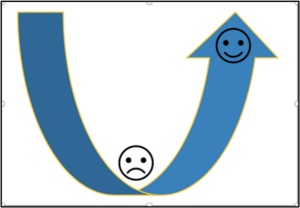In late March, when the Covid-19 lockdown was still new for so many of us, I had a fascinating experience. I was working with the leadership groups of two different organizations regarding how each could achieve their organizational goals in the context of a pandemic. Coincidentally, my meetings with the two leadership groups were within hours of one another. The first group launched itself into the lockdown with energy and fervour. They grasped this bull by its horns and, with enthusiasm, shared with me their plans for the coming months. I anticipated a similar exhilaration at my meeting with the second group, as the two groups with whom I am working are similar in many ways. I was unprepared for what occurred. The second group appeared bowled over by the pandemic, both exhausted and overwhelmed.
One month later, I had a second set of meetings with each of these same leadership bodies. This time, my meeting with the second group came first. To my surprise, they were energized, enthusiastic, and fully prepared to pursue their goals, designing creative strategies to accommodate the pandemic lockdown. As I planned to meet with the first group, I anticipated more of the same. Instead, I was surprised again – but not because of their excitement. Instead, the first group now seemed bowled over by the pandemic, both exhausted and overwhelmed.

What happened? How do we understand this leadership flip-flop? The short answer is this: When it comes to navigating change, there is no zip-line to take people from mountaintop to mountaintop, from an old normal to a new normal. Navigating change always includes going down into a valley before emerging, somehow transformed, on the other side. While the two leadership groups each pointed to various dynamics within their organizations to explain their respective shifts in energy and while these factors no doubt contributed to their demeanor, I remain convinced that at least part of the answer to their shift in energy lies with the realities associated with change management. The hard truth when it comes to change is that the path out always goes down before it goes up – as reflected in the image in this article. While the path down can be more or less painful, the reality of the path’s direction simply cannot be avoided, regardless of how confidently one enters into a time of change.
The other hard truth associated with this image is that when people are at the bottom of the curve, they naturally become overwhelmed and anxious – even if the change they are experiencing is desirable. Unfortunately, this space at the bottom of the change curve can lead to polarization, grief, self-absorption, loss of grace and self-regulation, etc. This is why many people resist change, why they long to return to the “good old days” or hope to catch a zip-line from one tip on the change curve to the other. The bottom of the change curve is simply uncomfortable – and for good reason. At the bottom of the curve, it is not so much the system that is changing as it is us. We too are being transformed in this space. In fact, even if a zip-line between mountaintops were available, it could not function properly. We would take off from one mountaintop, aiming for the other side, but we would lose speed along the way and would be caused to dangle somewhere between the two peaks, unable to move well in either direction. The reason we must go down before we come up is this: If we are genuinely in a change curve, it is not just the circumstances around us that are being changed. If, in the context of these changed circumstances, we are to arrive meaningfully on the other side, we must somehow fit in this new context. This means that we too must be changed. This, of course, is uncomfortable – both for leaders and for those they lead.
Leadership in the context of change is not for the faint of heart. Leaders go first into the valley. They guide the way down. And, despite their best-laid plans to minimize the pain of change, the reality of the valley means that they and the people they lead will experience the pain of the bottom of the curve. When this occurs, people often blame their leaders. For those familiar with the story of Moses, this is why the people he led out of Egypt became angry with him and even clamored to return to the slavery they had just left. To complicate matters even further, when people are at the bottom of the curve, their need for care from their leaders goes up not down; but, as leaders devote increased time to navigating the change their organization is experiencing, their availability to give care goes down not up. All of this is made even more difficult when the change curve is long and protracted and the path out remains unclear for some time.
The bottom of the valley is a tricky time for leaders and for the people they lead. But there is also a great gift in the bottom of the curve. Despite the difficulties endemic to this station on the change curve, the bottom of the curve is also where wisdom is mined, leadership mettle is tested, and new and often better ways of being in the world are developed. As my mother is fond of saying, “In life, we look for mountaintop experiences, but the fertilizer is in the valleys.” We are transformed in the valley; and often, we emerge as better people because of our time in this place.
For leaders, the reality of the change curve means becoming comfortable with being mired in fertilizer, while offering care for the people we find there with us. This requires great patience, self-compassion, and resilience. While one is experiencing one’s own feelings regarding the change – and while one is busy navigating the way through the valley to the other side of the change – one must still reach out to the people one is leading, even when they are grumpy about their own fertilizer moments. It is a tall order. My hope is that we find some comfort in the knowledge that the bottom of the valley is not only normal, it is necessary. It is the place where great transformations happen, allowing us to emerge more whole on the other side and more capable of fitting with the new normal of the changed circumstances in which we find ourselves.
